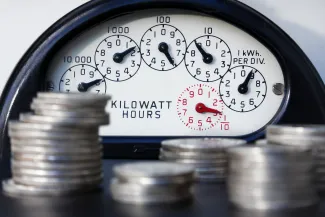
‘Valuable and largely overlooked:’ Interest in virtual power plants grows
(Colorado Newsline) Just about every week, Shawn Grant, who works for Salt Lake City-based Rocky Mountain Power, gets an inquiry from another utility looking for information about the company’s Wattsmart battery program.
“We want to do something. … How did you guys do it?’” Grant, the company’s customer innovation manager, says he’s often asked. “We’re always fielding those questions.”

© iStock
The program pays customers with solar who opt to install battery storage systems for the ability to use that stored electricity to help balance flows on the electric grid.
For customers, the benefits come in the form of lower electric bills and backup power in case of an outage. For Rocky Mountain Power, which has 1.2 million customers in Utah, Wyoming and Idaho, the program allows the company to harness the collective power stored in those distributed batteries to shave electric demand when it spikes rather than calling for more generation from a traditional power plant, among other uses.
“We’re using every battery every day to reduce demand on the grid,” Grant said.
The concept is known as a virtual power plant, and grid operators, utilities, state regulators and lawmakers across the country are increasingly exploring the possibilities. They are seen as a cost-effective way to aid an electric grid that in many parts of the country is increasingly embattled by power plant retirements as well as difficulties building new, cleaner generation and the transmission lines they need — all at a time when huge projected electric demand increases loom.
“We’re now in this load-growth era,” said Robin Dutta, acting executive director at the Chesapeake Solar and Storage Association, a solar and storage industry group focused on Maryland, Virginia and Washington, D.C. “When you’re mitigating peak demand growth at the source, that’s perhaps the most cost effective way to modernize the grid.”
‘Faster, better, cheaper’
Nearly 800,000 American homes installed a new solar or solar and energy storage system in 2023, according to the Solar Energy Industry Association. That growth set a record, with about 6.8 gigawatts installed, a 12 percent increase from 2022. Electric vehicles, another potential grid resource as a store of energy, also broke a sales record last year, despite consumer uptake being slower than some expected.

“These are devices that people are buying anyway because they’re faster, better, cheaper and virtual power plants allows everybody to leverage these devices while putting some money back in the pockets of people that bought the thing in the first place,” said Brian Turner, a director at Advanced Energy United, a clean energy trade group
The U.S. Department of Energy found in a report last year that large-scale deployment of virtual power plants “could help address demand increases and rising peaks at lower cost than conventional resources, reducing the energy costs for Americans — one in six of whom are already behind on electricity bills.”
These are devices that people are buying anyway because they’re faster, better, cheaper and virtual power plants allows everybody to leverage these devices while putting some money back in the pockets of people that bought the thing in the first place.
– Brian Turner, of Advanced Energy United
They’re not a new concept, the DOE noted, adding that most existing virtual power plants are so-called demand response programs. In Virginia, for example, the commonwealth for years has run a program that enrolls hundreds of public facilities (airports, universities, K-12 schools, municipal buildings, water treatment plants and others) that agree to reduce or shift their electric demand to relieve strain on the grid. The DOE report says deploying 80 to 160 gigawatts of virtual power plants by 2030 could save about $10 billion in annual grid costs and would “direct grid spending back to electricity consumers.” At that scale, virtual power plants could meet between 10 and 20 percent of peak electric demand. The Rocky Mountain Institute, a research nonprofit focused on sustainability, called virtual power plants “a valuable and largely overlooked resource for advancing key grid objectives,” including reliability, affordability, decarbonization and electrification, among others.
However, many states are starting to take notice of the potential:
- Maryland’s legislature just passed a bill that, among other provisions, requires utilities to create a pilot program to compensate owners of distributed energy resources like solar and battery storage for services they provide to the grid. “Ratepayers and consumers who invest in clean energy systems should see financial benefits when they provide meaningful grid services,” said Del. David Fraser-Hidalgo, a Democrat from Montgomery County who carried the House version of the bill. “Our DRIVE Act does just that; pairing battery storage with renewable generation will help Maryland achieve its clean energy goals, reduce our dependence on fossil fuels and mitigate the negative impacts of climate change.”
- Michigan, afflicted by expensive electric prices and high outage rates, has pending legislation, part of a package of pro-solar bills, that would create a virtual power plant program.
- In North Carolina, the state’s Utilities Commission has approved a Duke Energy pilot, called the PowerPair program, that it had directed the company to propose that will give customers incentives to install solar and storage. One group of customers will turn over control of the batteries to the utility and the other will participate in a test of “time-of-use rates,” which aim to shift customers’ usage to periods of lower demand, like running a dishwasher overnight, Utility Dive reported.
- In the summer of 2022, the New England Independent System Operator, which manages the electric grid for Maine, Vermont, New Hampshire, Massachusetts, Rhode Island and Connecticut, became the first such organization to use a virtual power plant, Politico’s E&E News reported. Sunrun, one of the nation’s largest solar installers, said it linked an estimated 5,000 small solar and battery systems to share 1.8 gigawatt hours of energy. In the summer of 2022, during a heat wave that sent temperatures soaring across New England states, residential and other non-utility solar installations reduced demand on the system by about 4,000 megawatts.
- The Pennsylvania Public Utility Commission announced in February that it was seeking comment on proposed rules related to use of distributed energy resources and virtual power plants. “Distributed resources provide the possibility for those who were traditionally consumers to play an active role in ensuring electric reliability and resiliency for themselves and their neighbors, and often in a less expensive way than traditional large generation that requires delivery infrastructure,” the commission’s chair and vice chair said in a joint statement.
- Arizona Public Service, the largest electric utility in the state, counts 75,000 smart residential thermostats in its Cool Reward program, which provided nearly 110 megawatts of capacity during the summer of 2022.
- A Colorado utility regulator is pushing for Xcel Energy to get a 50 megawatt virtual power plant up and running by the end of 2024, Utility Dive reported. The company, the state’s largest utility, already has a program called Renewable Battery Connect that allows it to discharge participating customers’ batteries during peak periods in exchange for financial incentives.
- In November, Puget Sound Energy, Washington’s largest utility, and AutoGrid, a California software company that provides distributed energy management systems, announced that they were expanding their partnership to develop a virtual power plant. “PSE’s VPP will reduce costs and help maintain reliable energy supply to its more than 1 million residential and business customers. Additionally, the VPP solution allows participating customers to receive monetary incentives for sharing assets with the grid and/or curtailing usage, something that’s financially beneficial for the community as well as helping the utility efficiently manage increasing electricity demand,” the companies said in a news release.
Why it matters
Experts who study and run the nation’s electric grid are worried about the pace of the energy transition. Old coal and gas plant retirements are accelerating, driven by economics, state clean energy policies and utilities’ own decarbonization goals. At the same time, massive backlogs in the queues to connect new power resources — overwhelmingly wind, solar and battery projects — in the regional transmission organizations that run the grid in much of the country mean big delays in replacing that retiring power generation. And after roughly a decade of flat electric demand, load growth is projected by many experts to explode as a result of transportation, industrial and home heating electrification, as well as a surge in data center development, among other factors. Throw in the fact that the construction of new transmission lines, essential to get excess power to where it might be urgently needed, has also stagnated and a problematic picture emerges.
“Most utilities in the country are planning on pretty significant load growth,” said Turner from Advanced Energy United. ”They could plan to build a new peaker plant or they could plan to ‘build’ VPPs.”
That’s where utility incentives come into play.
Generally speaking, Turner said, utilities that operate transmission and distribution systems are more friendly to the idea. Companies that also own their own generation — and make a sizable chunk of their income from guaranteed profits on building new plants — might not like the idea of a program that erodes the business case for a pricey new facility.
“That’s why we have utility commissions,” Turner said. “They exist to say to the utility that virtual power plants are a cheaper option for the ratepayer and therefore you should implement it.”
However, even companies that might have resisted the idea are facing such dire electric-demand growth scenarios that virtual power plants may be attractive ways to get more flexibility out of the grid more quickly than building new generation.
“This is a way to get the capacity online faster and oftentimes cheaper,” Turner said. “Meeting that load growth is a real challenge in a lot of places.”
Colorado Newsline is part of States Newsroom, a nonprofit news network supported by grants and a coalition of donors as a 501c(3) public charity. Colorado Newsline maintains editorial independence. Contact Editor Quentin Young for questions: info@coloradonewsline.com. Follow Colorado Newsline on Facebook and Twitter.
















